MGBBT1TEN: Analysis of Italy's Tourism Environment and Industry Report
VerifiedAdded on 2023/06/07
|10
|2507
|284
Report
AI Summary
This report provides a detailed analysis of the tourism environment and industry in Italy, focusing on sustainable tourism practices. It begins with an introduction to the concept of tourism and the significance of Italy as a prominent tourist destination, highlighting its rich history and scenic landscapes. The main body explores sustainable tourism principles, emphasizing the importance of environmental protection, community benefit, and economic viability. It examines the role of stakeholders in decision-making processes within the tourism sector, categorizing them based on their influence and impact. The report further delves into macro environmental factors, such as social, technological, economic, environmental, and legal aspects, and how these factors contribute to sustainability. Additionally, it discusses micro environmental factors and their influence on tourist demand, including price and non-price factors. The report concludes by summarizing the key findings and emphasizing the importance of sustainable development in maintaining a clean and healthy environment for tourists.
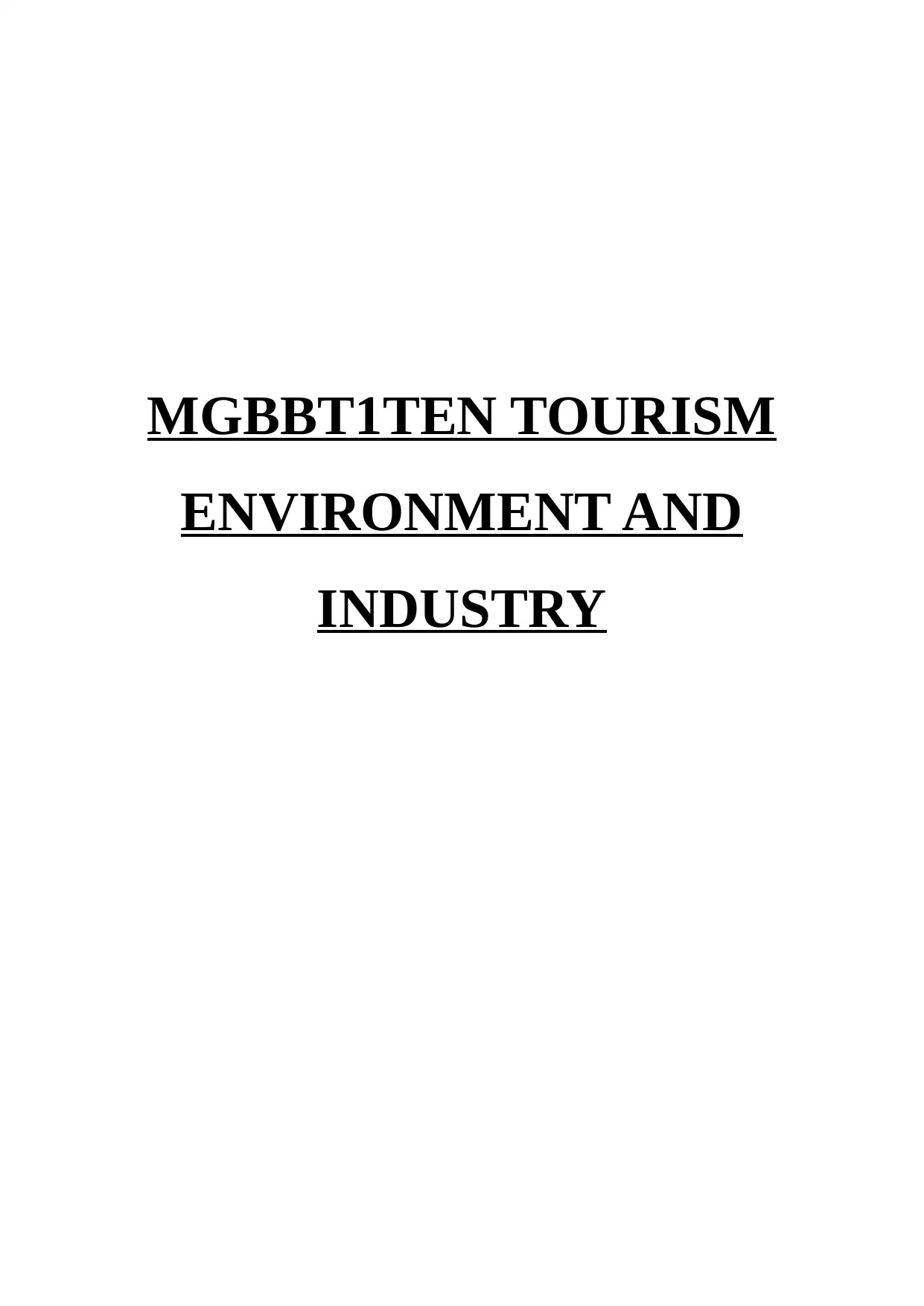
MGBBT1TEN TOURISM
ENVIRONMENT AND
INDUSTRY
ENVIRONMENT AND
INDUSTRY
Paraphrase This Document
Need a fresh take? Get an instant paraphrase of this document with our AI Paraphraser
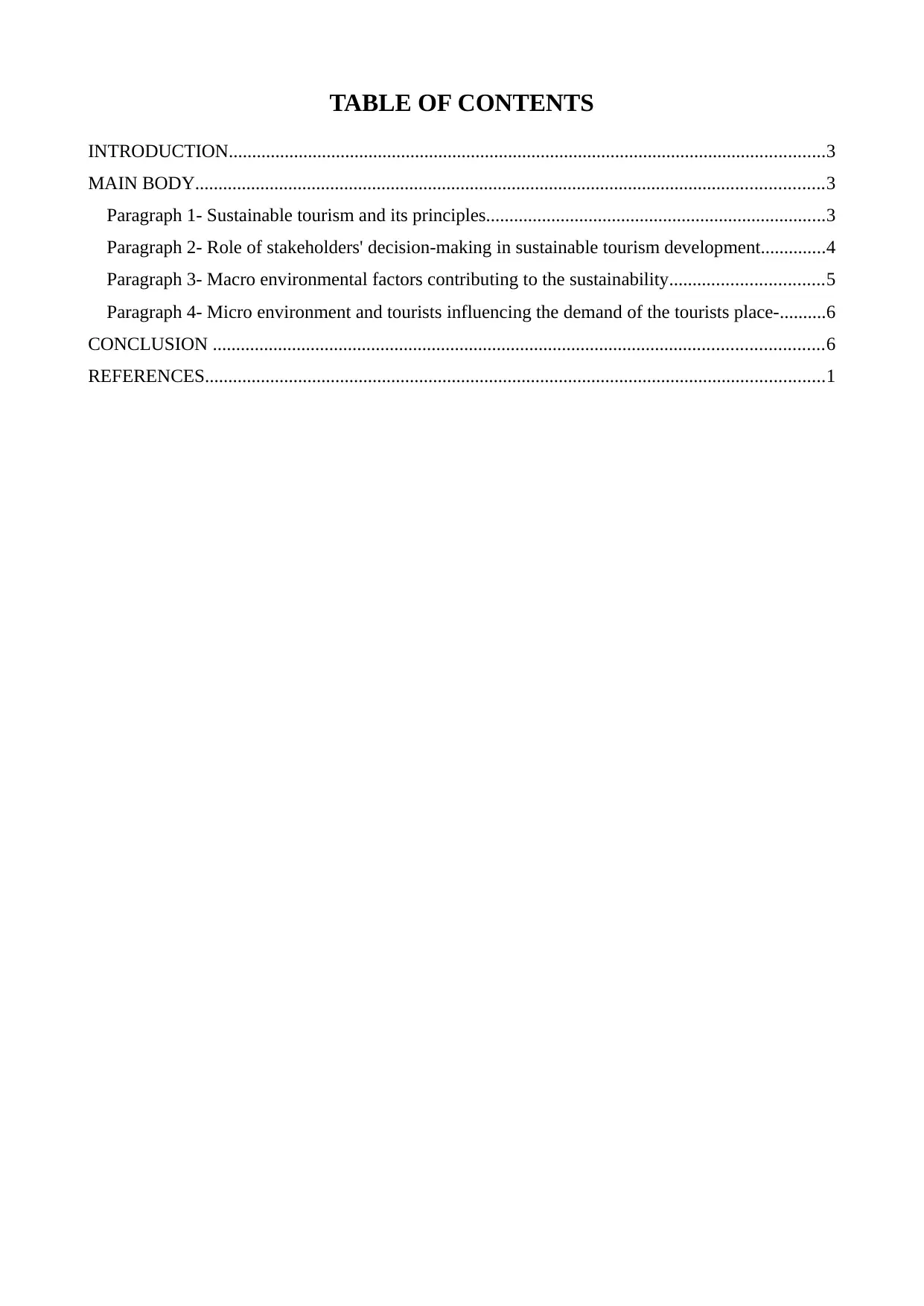
TABLE OF CONTENTS
INTRODUCTION................................................................................................................................3
MAIN BODY.......................................................................................................................................3
Paragraph 1- Sustainable tourism and its principles.........................................................................3
Paragraph 2- Role of stakeholders' decision-making in sustainable tourism development..............4
Paragraph 3- Macro environmental factors contributing to the sustainability.................................5
Paragraph 4- Micro environment and tourists influencing the demand of the tourists place-..........6
CONCLUSION ...................................................................................................................................6
REFERENCES.....................................................................................................................................1
INTRODUCTION................................................................................................................................3
MAIN BODY.......................................................................................................................................3
Paragraph 1- Sustainable tourism and its principles.........................................................................3
Paragraph 2- Role of stakeholders' decision-making in sustainable tourism development..............4
Paragraph 3- Macro environmental factors contributing to the sustainability.................................5
Paragraph 4- Micro environment and tourists influencing the demand of the tourists place-..........6
CONCLUSION ...................................................................................................................................6
REFERENCES.....................................................................................................................................1
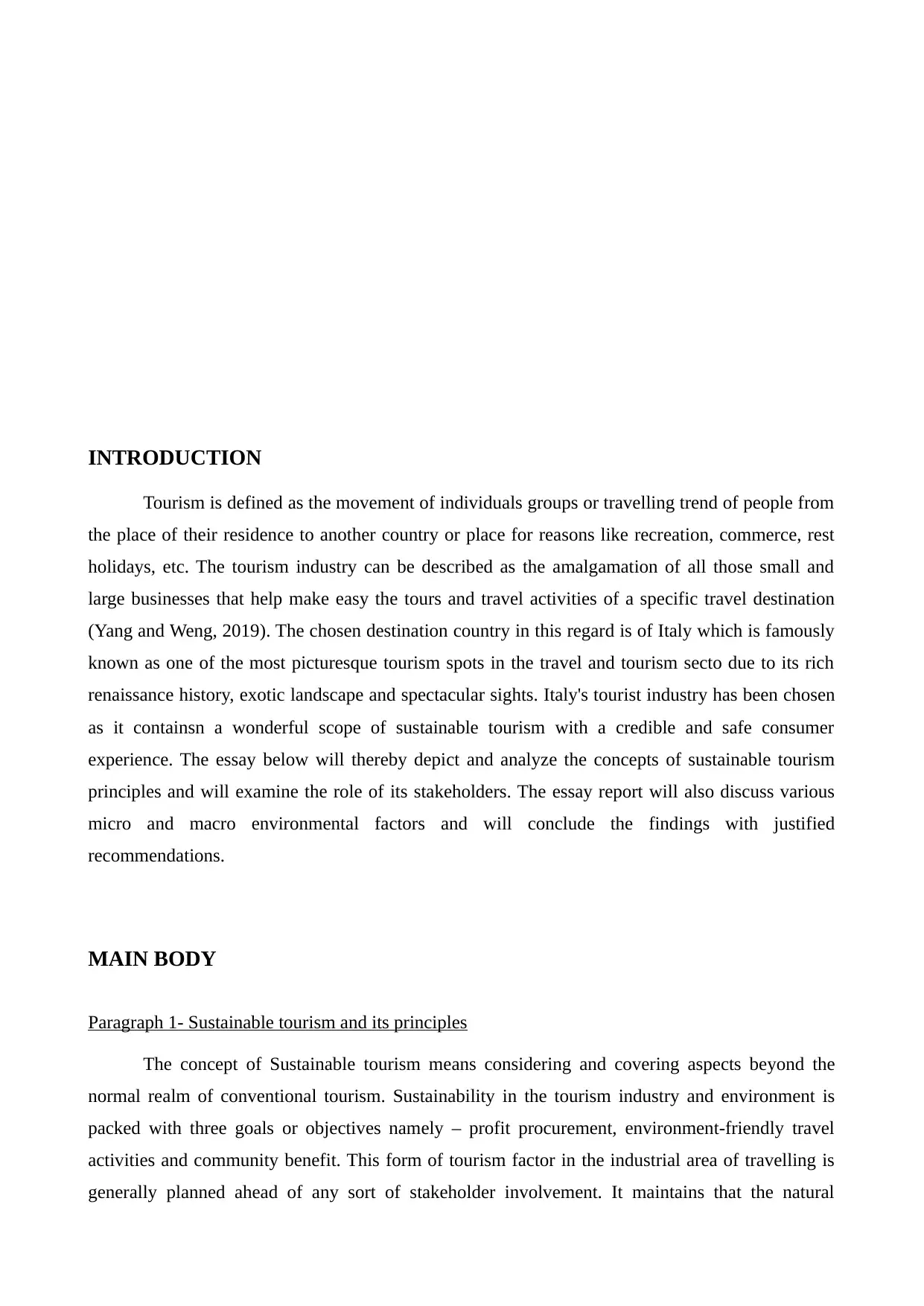
INTRODUCTION
Tourism is defined as the movement of individuals groups or travelling trend of people from
the place of their residence to another country or place for reasons like recreation, commerce, rest
holidays, etc. The tourism industry can be described as the amalgamation of all those small and
large businesses that help make easy the tours and travel activities of a specific travel destination
(Yang and Weng, 2019). The chosen destination country in this regard is of Italy which is famously
known as one of the most picturesque tourism spots in the travel and tourism secto due to its rich
renaissance history, exotic landscape and spectacular sights. Italy's tourist industry has been chosen
as it containsn a wonderful scope of sustainable tourism with a credible and safe consumer
experience. The essay below will thereby depict and analyze the concepts of sustainable tourism
principles and will examine the role of its stakeholders. The essay report will also discuss various
micro and macro environmental factors and will conclude the findings with justified
recommendations.
MAIN BODY
Paragraph 1- Sustainable tourism and its principles
The concept of Sustainable tourism means considering and covering aspects beyond the
normal realm of conventional tourism. Sustainability in the tourism industry and environment is
packed with three goals or objectives namely – profit procurement, environment-friendly travel
activities and community benefit. This form of tourism factor in the industrial area of travelling is
generally planned ahead of any sort of stakeholder involvement. It maintains that the natural
Tourism is defined as the movement of individuals groups or travelling trend of people from
the place of their residence to another country or place for reasons like recreation, commerce, rest
holidays, etc. The tourism industry can be described as the amalgamation of all those small and
large businesses that help make easy the tours and travel activities of a specific travel destination
(Yang and Weng, 2019). The chosen destination country in this regard is of Italy which is famously
known as one of the most picturesque tourism spots in the travel and tourism secto due to its rich
renaissance history, exotic landscape and spectacular sights. Italy's tourist industry has been chosen
as it containsn a wonderful scope of sustainable tourism with a credible and safe consumer
experience. The essay below will thereby depict and analyze the concepts of sustainable tourism
principles and will examine the role of its stakeholders. The essay report will also discuss various
micro and macro environmental factors and will conclude the findings with justified
recommendations.
MAIN BODY
Paragraph 1- Sustainable tourism and its principles
The concept of Sustainable tourism means considering and covering aspects beyond the
normal realm of conventional tourism. Sustainability in the tourism industry and environment is
packed with three goals or objectives namely – profit procurement, environment-friendly travel
activities and community benefit. This form of tourism factor in the industrial area of travelling is
generally planned ahead of any sort of stakeholder involvement. It maintains that the natural
⊘ This is a preview!⊘
Do you want full access?
Subscribe today to unlock all pages.

Trusted by 1+ million students worldwide
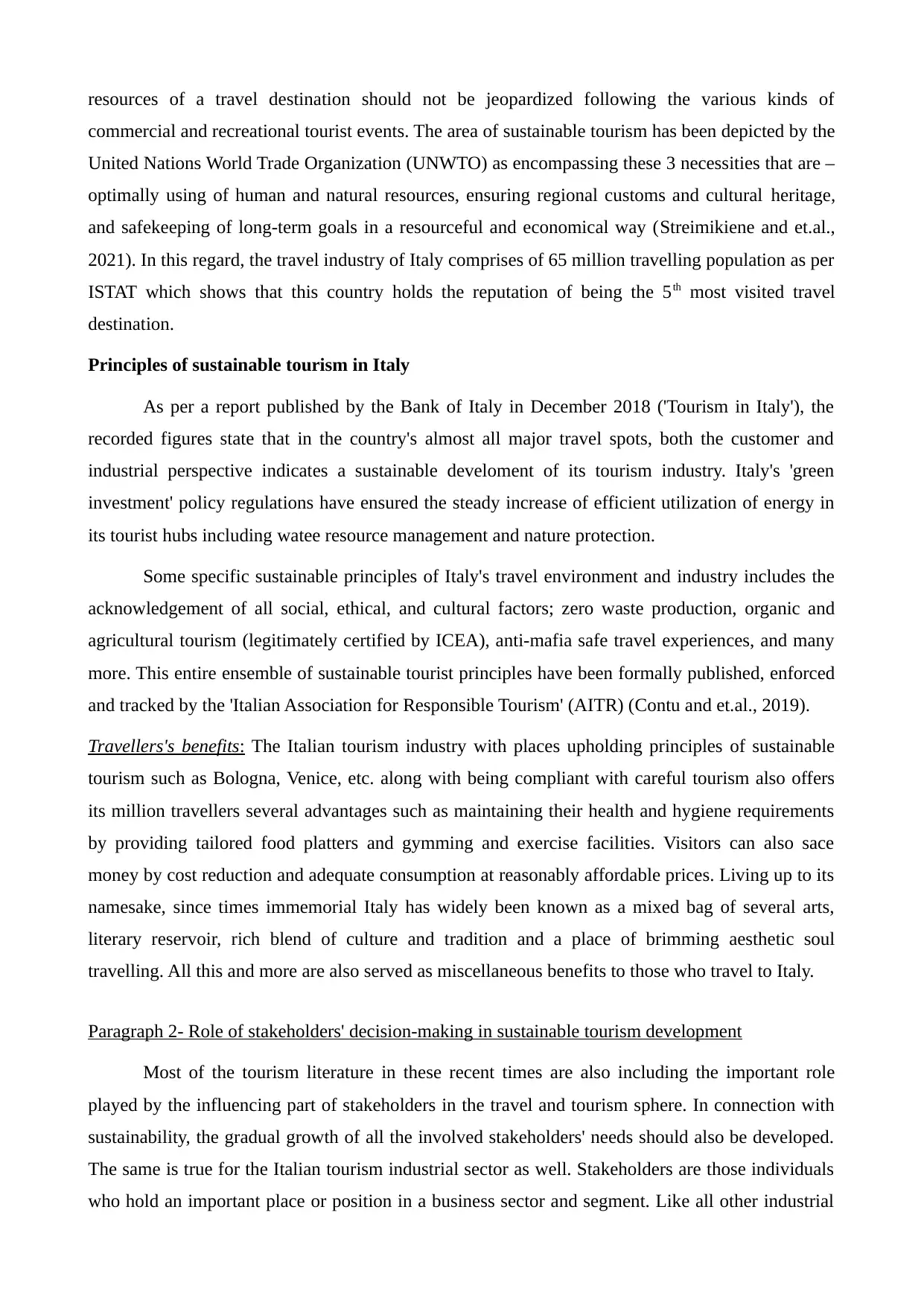
resources of a travel destination should not be jeopardized following the various kinds of
commercial and recreational tourist events. The area of sustainable tourism has been depicted by the
United Nations World Trade Organization (UNWTO) as encompassing these 3 necessities that are –
optimally using of human and natural resources, ensuring regional customs and cultural heritage,
and safekeeping of long-term goals in a resourceful and economical way (Streimikiene and et.al.,
2021). In this regard, the travel industry of Italy comprises of 65 million travelling population as per
ISTAT which shows that this country holds the reputation of being the 5th most visited travel
destination.
Principles of sustainable tourism in Italy
As per a report published by the Bank of Italy in December 2018 ('Tourism in Italy'), the
recorded figures state that in the country's almost all major travel spots, both the customer and
industrial perspective indicates a sustainable develoment of its tourism industry. Italy's 'green
investment' policy regulations have ensured the steady increase of efficient utilization of energy in
its tourist hubs including watee resource management and nature protection.
Some specific sustainable principles of Italy's travel environment and industry includes the
acknowledgement of all social, ethical, and cultural factors; zero waste production, organic and
agricultural tourism (legitimately certified by ICEA), anti-mafia safe travel experiences, and many
more. This entire ensemble of sustainable tourist principles have been formally published, enforced
and tracked by the 'Italian Association for Responsible Tourism' (AITR) (Contu and et.al., 2019).
Travellers's benefits: The Italian tourism industry with places upholding principles of sustainable
tourism such as Bologna, Venice, etc. along with being compliant with careful tourism also offers
its million travellers several advantages such as maintaining their health and hygiene requirements
by providing tailored food platters and gymming and exercise facilities. Visitors can also sace
money by cost reduction and adequate consumption at reasonably affordable prices. Living up to its
namesake, since times immemorial Italy has widely been known as a mixed bag of several arts,
literary reservoir, rich blend of culture and tradition and a place of brimming aesthetic soul
travelling. All this and more are also served as miscellaneous benefits to those who travel to Italy.
Paragraph 2- Role of stakeholders' decision-making in sustainable tourism development
Most of the tourism literature in these recent times are also including the important role
played by the influencing part of stakeholders in the travel and tourism sphere. In connection with
sustainability, the gradual growth of all the involved stakeholders' needs should also be developed.
The same is true for the Italian tourism industrial sector as well. Stakeholders are those individuals
who hold an important place or position in a business sector and segment. Like all other industrial
commercial and recreational tourist events. The area of sustainable tourism has been depicted by the
United Nations World Trade Organization (UNWTO) as encompassing these 3 necessities that are –
optimally using of human and natural resources, ensuring regional customs and cultural heritage,
and safekeeping of long-term goals in a resourceful and economical way (Streimikiene and et.al.,
2021). In this regard, the travel industry of Italy comprises of 65 million travelling population as per
ISTAT which shows that this country holds the reputation of being the 5th most visited travel
destination.
Principles of sustainable tourism in Italy
As per a report published by the Bank of Italy in December 2018 ('Tourism in Italy'), the
recorded figures state that in the country's almost all major travel spots, both the customer and
industrial perspective indicates a sustainable develoment of its tourism industry. Italy's 'green
investment' policy regulations have ensured the steady increase of efficient utilization of energy in
its tourist hubs including watee resource management and nature protection.
Some specific sustainable principles of Italy's travel environment and industry includes the
acknowledgement of all social, ethical, and cultural factors; zero waste production, organic and
agricultural tourism (legitimately certified by ICEA), anti-mafia safe travel experiences, and many
more. This entire ensemble of sustainable tourist principles have been formally published, enforced
and tracked by the 'Italian Association for Responsible Tourism' (AITR) (Contu and et.al., 2019).
Travellers's benefits: The Italian tourism industry with places upholding principles of sustainable
tourism such as Bologna, Venice, etc. along with being compliant with careful tourism also offers
its million travellers several advantages such as maintaining their health and hygiene requirements
by providing tailored food platters and gymming and exercise facilities. Visitors can also sace
money by cost reduction and adequate consumption at reasonably affordable prices. Living up to its
namesake, since times immemorial Italy has widely been known as a mixed bag of several arts,
literary reservoir, rich blend of culture and tradition and a place of brimming aesthetic soul
travelling. All this and more are also served as miscellaneous benefits to those who travel to Italy.
Paragraph 2- Role of stakeholders' decision-making in sustainable tourism development
Most of the tourism literature in these recent times are also including the important role
played by the influencing part of stakeholders in the travel and tourism sphere. In connection with
sustainability, the gradual growth of all the involved stakeholders' needs should also be developed.
The same is true for the Italian tourism industrial sector as well. Stakeholders are those individuals
who hold an important place or position in a business sector and segment. Like all other industrial
Paraphrase This Document
Need a fresh take? Get an instant paraphrase of this document with our AI Paraphraser
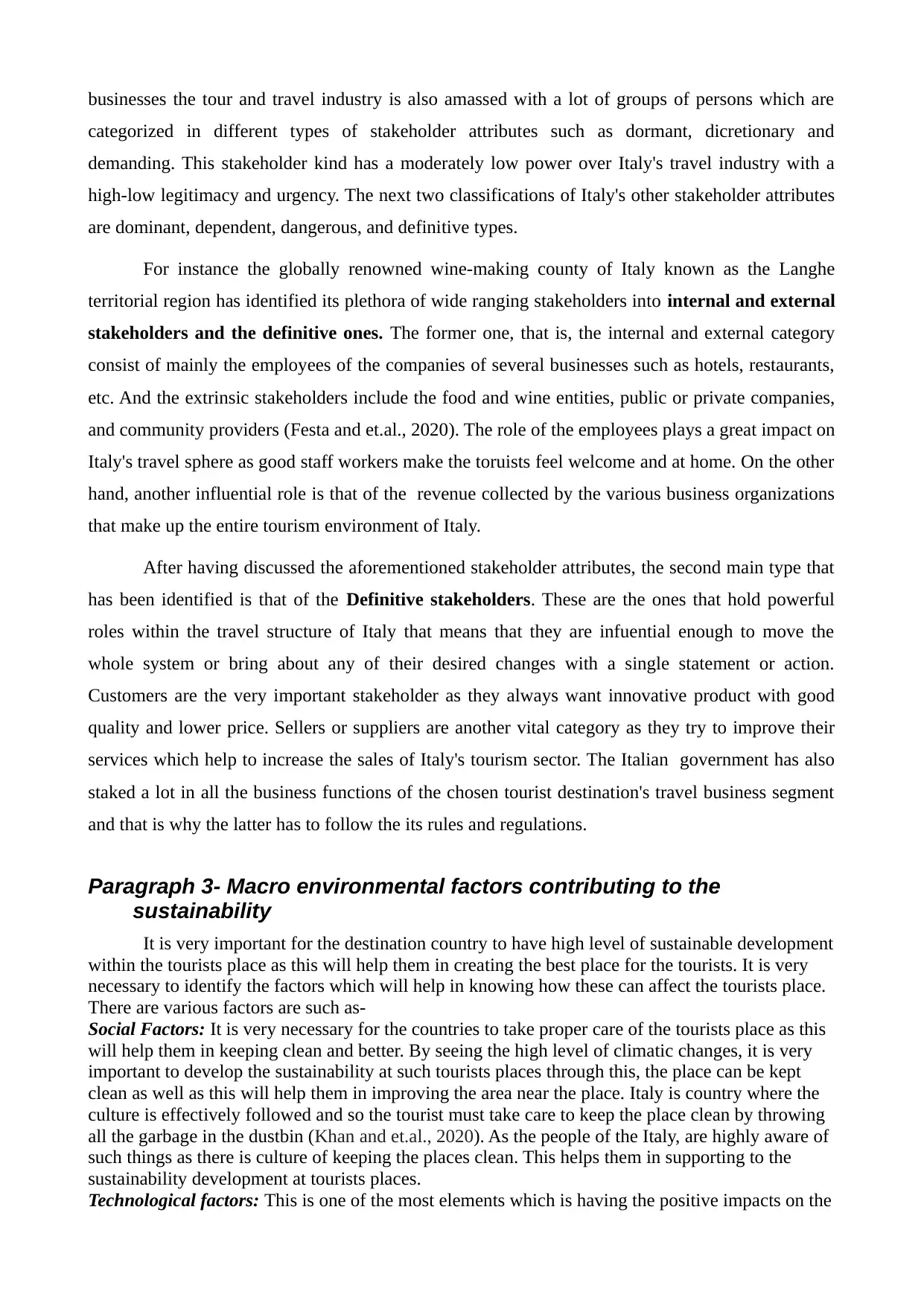
businesses the tour and travel industry is also amassed with a lot of groups of persons which are
categorized in different types of stakeholder attributes such as dormant, dicretionary and
demanding. This stakeholder kind has a moderately low power over Italy's travel industry with a
high-low legitimacy and urgency. The next two classifications of Italy's other stakeholder attributes
are dominant, dependent, dangerous, and definitive types.
For instance the globally renowned wine-making county of Italy known as the Langhe
territorial region has identified its plethora of wide ranging stakeholders into internal and external
stakeholders and the definitive ones. The former one, that is, the internal and external category
consist of mainly the employees of the companies of several businesses such as hotels, restaurants,
etc. And the extrinsic stakeholders include the food and wine entities, public or private companies,
and community providers (Festa and et.al., 2020). The role of the employees plays a great impact on
Italy's travel sphere as good staff workers make the toruists feel welcome and at home. On the other
hand, another influential role is that of the revenue collected by the various business organizations
that make up the entire tourism environment of Italy.
After having discussed the aforementioned stakeholder attributes, the second main type that
has been identified is that of the Definitive stakeholders. These are the ones that hold powerful
roles within the travel structure of Italy that means that they are infuential enough to move the
whole system or bring about any of their desired changes with a single statement or action.
Customers are the very important stakeholder as they always want innovative product with good
quality and lower price. Sellers or suppliers are another vital category as they try to improve their
services which help to increase the sales of Italy's tourism sector. The Italian government has also
staked a lot in all the business functions of the chosen tourist destination's travel business segment
and that is why the latter has to follow the its rules and regulations.
Paragraph 3- Macro environmental factors contributing to the
sustainability
It is very important for the destination country to have high level of sustainable development
within the tourists place as this will help them in creating the best place for the tourists. It is very
necessary to identify the factors which will help in knowing how these can affect the tourists place.
There are various factors are such as-
Social Factors: It is very necessary for the countries to take proper care of the tourists place as this
will help them in keeping clean and better. By seeing the high level of climatic changes, it is very
important to develop the sustainability at such tourists places through this, the place can be kept
clean as well as this will help them in improving the area near the place. Italy is country where the
culture is effectively followed and so the tourist must take care to keep the place clean by throwing
all the garbage in the dustbin (Khan and et.al., 2020). As the people of the Italy, are highly aware of
such things as there is culture of keeping the places clean. This helps them in supporting to the
sustainability development at tourists places.
Technological factors: This is one of the most elements which is having the positive impacts on the
categorized in different types of stakeholder attributes such as dormant, dicretionary and
demanding. This stakeholder kind has a moderately low power over Italy's travel industry with a
high-low legitimacy and urgency. The next two classifications of Italy's other stakeholder attributes
are dominant, dependent, dangerous, and definitive types.
For instance the globally renowned wine-making county of Italy known as the Langhe
territorial region has identified its plethora of wide ranging stakeholders into internal and external
stakeholders and the definitive ones. The former one, that is, the internal and external category
consist of mainly the employees of the companies of several businesses such as hotels, restaurants,
etc. And the extrinsic stakeholders include the food and wine entities, public or private companies,
and community providers (Festa and et.al., 2020). The role of the employees plays a great impact on
Italy's travel sphere as good staff workers make the toruists feel welcome and at home. On the other
hand, another influential role is that of the revenue collected by the various business organizations
that make up the entire tourism environment of Italy.
After having discussed the aforementioned stakeholder attributes, the second main type that
has been identified is that of the Definitive stakeholders. These are the ones that hold powerful
roles within the travel structure of Italy that means that they are infuential enough to move the
whole system or bring about any of their desired changes with a single statement or action.
Customers are the very important stakeholder as they always want innovative product with good
quality and lower price. Sellers or suppliers are another vital category as they try to improve their
services which help to increase the sales of Italy's tourism sector. The Italian government has also
staked a lot in all the business functions of the chosen tourist destination's travel business segment
and that is why the latter has to follow the its rules and regulations.
Paragraph 3- Macro environmental factors contributing to the
sustainability
It is very important for the destination country to have high level of sustainable development
within the tourists place as this will help them in creating the best place for the tourists. It is very
necessary to identify the factors which will help in knowing how these can affect the tourists place.
There are various factors are such as-
Social Factors: It is very necessary for the countries to take proper care of the tourists place as this
will help them in keeping clean and better. By seeing the high level of climatic changes, it is very
important to develop the sustainability at such tourists places through this, the place can be kept
clean as well as this will help them in improving the area near the place. Italy is country where the
culture is effectively followed and so the tourist must take care to keep the place clean by throwing
all the garbage in the dustbin (Khan and et.al., 2020). As the people of the Italy, are highly aware of
such things as there is culture of keeping the places clean. This helps them in supporting to the
sustainability development at tourists places.
Technological factors: This is one of the most elements which is having the positive impacts on the
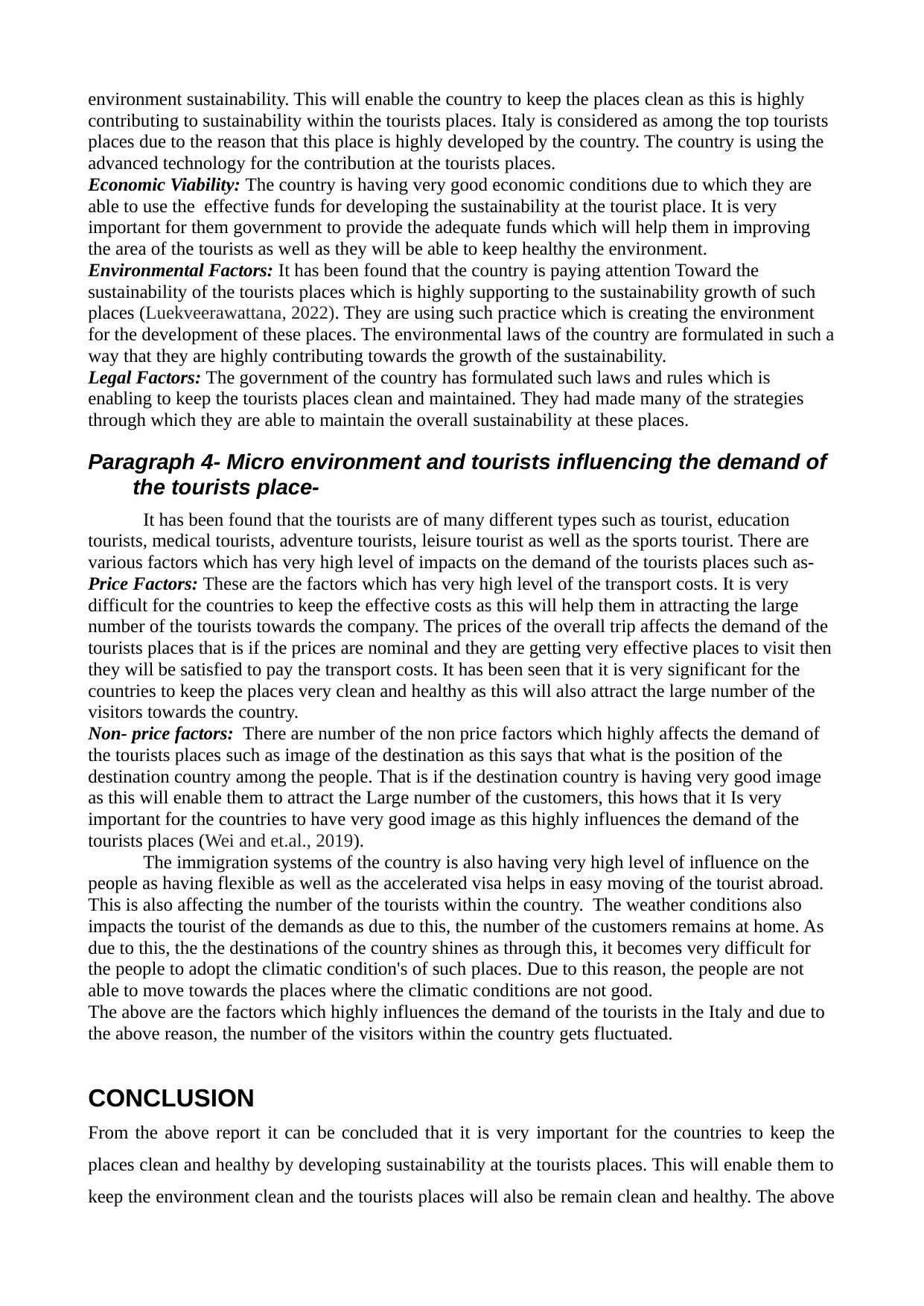
environment sustainability. This will enable the country to keep the places clean as this is highly
contributing to sustainability within the tourists places. Italy is considered as among the top tourists
places due to the reason that this place is highly developed by the country. The country is using the
advanced technology for the contribution at the tourists places.
Economic Viability: The country is having very good economic conditions due to which they are
able to use the effective funds for developing the sustainability at the tourist place. It is very
important for them government to provide the adequate funds which will help them in improving
the area of the tourists as well as they will be able to keep healthy the environment.
Environmental Factors: It has been found that the country is paying attention Toward the
sustainability of the tourists places which is highly supporting to the sustainability growth of such
places (Luekveerawattana, 2022). They are using such practice which is creating the environment
for the development of these places. The environmental laws of the country are formulated in such a
way that they are highly contributing towards the growth of the sustainability.
Legal Factors: The government of the country has formulated such laws and rules which is
enabling to keep the tourists places clean and maintained. They had made many of the strategies
through which they are able to maintain the overall sustainability at these places.
Paragraph 4- Micro environment and tourists influencing the demand of
the tourists place-
It has been found that the tourists are of many different types such as tourist, education
tourists, medical tourists, adventure tourists, leisure tourist as well as the sports tourist. There are
various factors which has very high level of impacts on the demand of the tourists places such as-
Price Factors: These are the factors which has very high level of the transport costs. It is very
difficult for the countries to keep the effective costs as this will help them in attracting the large
number of the tourists towards the company. The prices of the overall trip affects the demand of the
tourists places that is if the prices are nominal and they are getting very effective places to visit then
they will be satisfied to pay the transport costs. It has been seen that it is very significant for the
countries to keep the places very clean and healthy as this will also attract the large number of the
visitors towards the country.
Non- price factors: There are number of the non price factors which highly affects the demand of
the tourists places such as image of the destination as this says that what is the position of the
destination country among the people. That is if the destination country is having very good image
as this will enable them to attract the Large number of the customers, this hows that it Is very
important for the countries to have very good image as this highly influences the demand of the
tourists places (Wei and et.al., 2019).
The immigration systems of the country is also having very high level of influence on the
people as having flexible as well as the accelerated visa helps in easy moving of the tourist abroad.
This is also affecting the number of the tourists within the country. The weather conditions also
impacts the tourist of the demands as due to this, the number of the customers remains at home. As
due to this, the the destinations of the country shines as through this, it becomes very difficult for
the people to adopt the climatic condition's of such places. Due to this reason, the people are not
able to move towards the places where the climatic conditions are not good.
The above are the factors which highly influences the demand of the tourists in the Italy and due to
the above reason, the number of the visitors within the country gets fluctuated.
CONCLUSION
From the above report it can be concluded that it is very important for the countries to keep the
places clean and healthy by developing sustainability at the tourists places. This will enable them to
keep the environment clean and the tourists places will also be remain clean and healthy. The above
contributing to sustainability within the tourists places. Italy is considered as among the top tourists
places due to the reason that this place is highly developed by the country. The country is using the
advanced technology for the contribution at the tourists places.
Economic Viability: The country is having very good economic conditions due to which they are
able to use the effective funds for developing the sustainability at the tourist place. It is very
important for them government to provide the adequate funds which will help them in improving
the area of the tourists as well as they will be able to keep healthy the environment.
Environmental Factors: It has been found that the country is paying attention Toward the
sustainability of the tourists places which is highly supporting to the sustainability growth of such
places (Luekveerawattana, 2022). They are using such practice which is creating the environment
for the development of these places. The environmental laws of the country are formulated in such a
way that they are highly contributing towards the growth of the sustainability.
Legal Factors: The government of the country has formulated such laws and rules which is
enabling to keep the tourists places clean and maintained. They had made many of the strategies
through which they are able to maintain the overall sustainability at these places.
Paragraph 4- Micro environment and tourists influencing the demand of
the tourists place-
It has been found that the tourists are of many different types such as tourist, education
tourists, medical tourists, adventure tourists, leisure tourist as well as the sports tourist. There are
various factors which has very high level of impacts on the demand of the tourists places such as-
Price Factors: These are the factors which has very high level of the transport costs. It is very
difficult for the countries to keep the effective costs as this will help them in attracting the large
number of the tourists towards the company. The prices of the overall trip affects the demand of the
tourists places that is if the prices are nominal and they are getting very effective places to visit then
they will be satisfied to pay the transport costs. It has been seen that it is very significant for the
countries to keep the places very clean and healthy as this will also attract the large number of the
visitors towards the country.
Non- price factors: There are number of the non price factors which highly affects the demand of
the tourists places such as image of the destination as this says that what is the position of the
destination country among the people. That is if the destination country is having very good image
as this will enable them to attract the Large number of the customers, this hows that it Is very
important for the countries to have very good image as this highly influences the demand of the
tourists places (Wei and et.al., 2019).
The immigration systems of the country is also having very high level of influence on the
people as having flexible as well as the accelerated visa helps in easy moving of the tourist abroad.
This is also affecting the number of the tourists within the country. The weather conditions also
impacts the tourist of the demands as due to this, the number of the customers remains at home. As
due to this, the the destinations of the country shines as through this, it becomes very difficult for
the people to adopt the climatic condition's of such places. Due to this reason, the people are not
able to move towards the places where the climatic conditions are not good.
The above are the factors which highly influences the demand of the tourists in the Italy and due to
the above reason, the number of the visitors within the country gets fluctuated.
CONCLUSION
From the above report it can be concluded that it is very important for the countries to keep the
places clean and healthy by developing sustainability at the tourists places. This will enable them to
keep the environment clean and the tourists places will also be remain clean and healthy. The above
⊘ This is a preview!⊘
Do you want full access?
Subscribe today to unlock all pages.

Trusted by 1+ million students worldwide

report has discussed the role of the stakeholders which is involves in the decision making within the
tourism sector as well as the principles of the sustainability within the destination country. Along
with this, the micro-environment and the macro environmental factors has been discussed which
impacts the demand of the tourism within the destination places.
tourism sector as well as the principles of the sustainability within the destination country. Along
with this, the micro-environment and the macro environmental factors has been discussed which
impacts the demand of the tourism within the destination places.
Paraphrase This Document
Need a fresh take? Get an instant paraphrase of this document with our AI Paraphraser
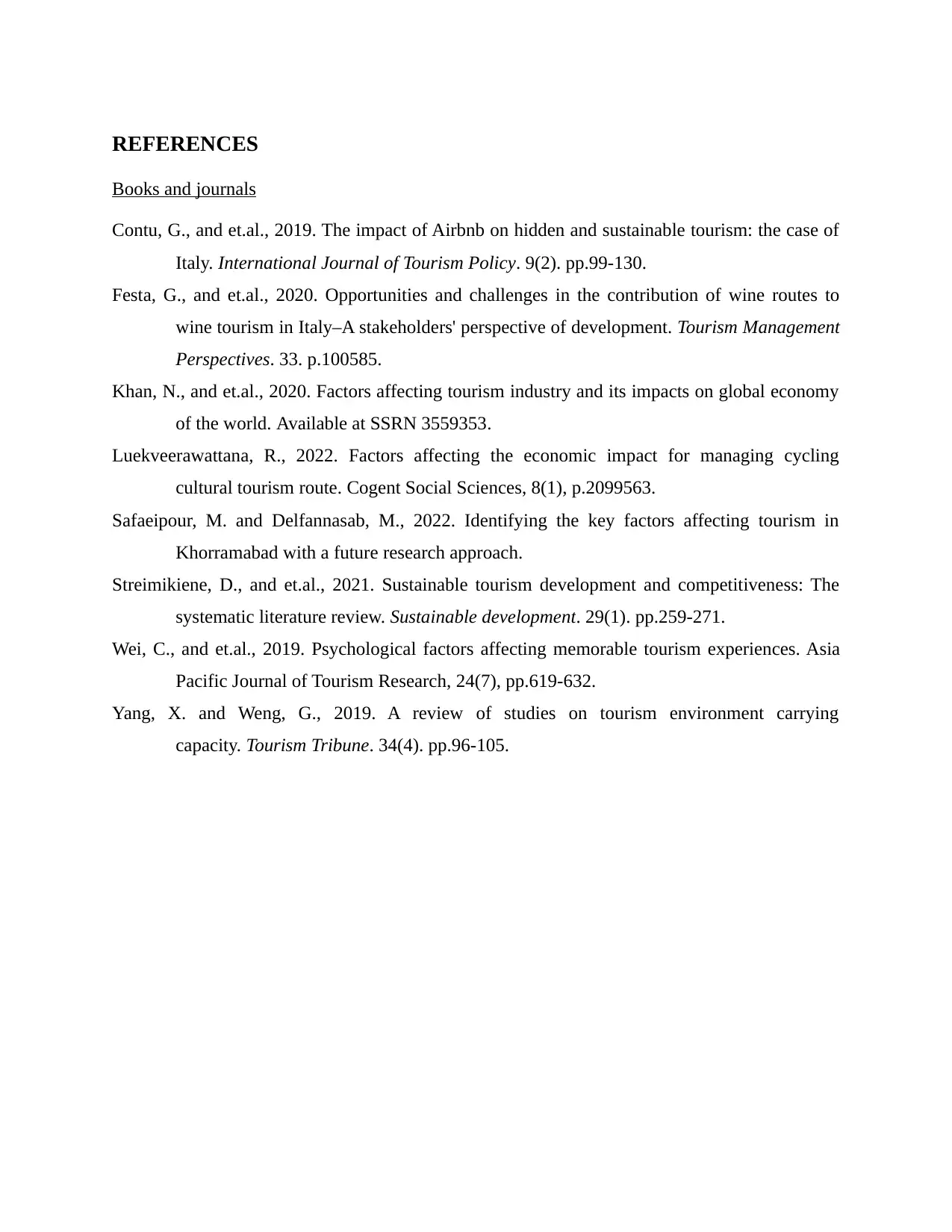
REFERENCES
Books and journals
Contu, G., and et.al., 2019. The impact of Airbnb on hidden and sustainable tourism: the case of
Italy. International Journal of Tourism Policy. 9(2). pp.99-130.
Festa, G., and et.al., 2020. Opportunities and challenges in the contribution of wine routes to
wine tourism in Italy–A stakeholders' perspective of development. Tourism Management
Perspectives. 33. p.100585.
Khan, N., and et.al., 2020. Factors affecting tourism industry and its impacts on global economy
of the world. Available at SSRN 3559353.
Luekveerawattana, R., 2022. Factors affecting the economic impact for managing cycling
cultural tourism route. Cogent Social Sciences, 8(1), p.2099563.
Safaeipour, M. and Delfannasab, M., 2022. Identifying the key factors affecting tourism in
Khorramabad with a future research approach.
Streimikiene, D., and et.al., 2021. Sustainable tourism development and competitiveness: The
systematic literature review. Sustainable development. 29(1). pp.259-271.
Wei, C., and et.al., 2019. Psychological factors affecting memorable tourism experiences. Asia
Pacific Journal of Tourism Research, 24(7), pp.619-632.
Yang, X. and Weng, G., 2019. A review of studies on tourism environment carrying
capacity. Tourism Tribune. 34(4). pp.96-105.
Books and journals
Contu, G., and et.al., 2019. The impact of Airbnb on hidden and sustainable tourism: the case of
Italy. International Journal of Tourism Policy. 9(2). pp.99-130.
Festa, G., and et.al., 2020. Opportunities and challenges in the contribution of wine routes to
wine tourism in Italy–A stakeholders' perspective of development. Tourism Management
Perspectives. 33. p.100585.
Khan, N., and et.al., 2020. Factors affecting tourism industry and its impacts on global economy
of the world. Available at SSRN 3559353.
Luekveerawattana, R., 2022. Factors affecting the economic impact for managing cycling
cultural tourism route. Cogent Social Sciences, 8(1), p.2099563.
Safaeipour, M. and Delfannasab, M., 2022. Identifying the key factors affecting tourism in
Khorramabad with a future research approach.
Streimikiene, D., and et.al., 2021. Sustainable tourism development and competitiveness: The
systematic literature review. Sustainable development. 29(1). pp.259-271.
Wei, C., and et.al., 2019. Psychological factors affecting memorable tourism experiences. Asia
Pacific Journal of Tourism Research, 24(7), pp.619-632.
Yang, X. and Weng, G., 2019. A review of studies on tourism environment carrying
capacity. Tourism Tribune. 34(4). pp.96-105.

⊘ This is a preview!⊘
Do you want full access?
Subscribe today to unlock all pages.

Trusted by 1+ million students worldwide

1 out of 10
Related Documents
Your All-in-One AI-Powered Toolkit for Academic Success.
+13062052269
info@desklib.com
Available 24*7 on WhatsApp / Email
![[object Object]](/_next/static/media/star-bottom.7253800d.svg)
Unlock your academic potential
Copyright © 2020–2025 A2Z Services. All Rights Reserved. Developed and managed by ZUCOL.



